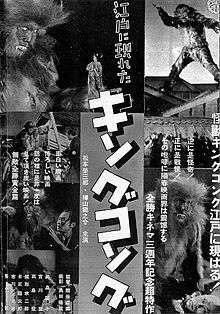King Kong Appears in Edo
King Kong Appears in Edo (江戸に現れたキングコング, Edo ni Arawareta Kingu Kongu) was a 1938 Japanese two-part silent period piece drama film set during the Edo period and produced by Zenshō Cinema.[2][3] It is now considered to be a lost film.[4][5]
| King Kong Appears in Edo | |
|---|---|
 Advertisement for the film, published in the April 14, 1938 issue of Kinema Junpo[1] | |
| Directed by | Sōya Kumagai |
| Written by | Daijō Aoyama |
| Starring | Eizaburo Matsumoto Ryūnosuke Kabayama Reizaburo Ichikawa Reiko Mishima Shōjirō Ogata Sanshirō Mōri Noboru Takashima |
| Cinematography | Yōzō Okuda |
| Distributed by | Zenshō Cinema |
Release date |
|
| Country | Japan |
| Language | Japanese |
Plot
One night, Chinami (Reiko Mishima), the daughter of Hyoue Toba (Reizaburo Ichikawa), is mysteriously kidnapped. Hyoue offers a large reward for his daughter's rescue. Yuzuru Kawasaki (Noboru Takashima) and various other men employed by Hyoue set about searching for Chinami. However one of Hyoue's men, Magonojyō Gō (Eizaburo Matsumoto), does not partake in the search, because he was the one who had Chinami kidnapped. Magonojyō's father Senbei has a trained pet ape named "King Kong" (Ryūnosuke Kabayama) and Magonojyō used this creature to perform the kidnapping. Magonojyō has a score to settle with Hyoue because he had forced Senbei to counterfeit coins. When Senbei refused to do so, he was imprisoned by Hyoue and eventually killed. This is why Magonojyō disguised his identity and went to work for Hyoue, to get close to him in order to get revenge. Magonojyō eventually corners Hyoue and threatens him with the ape. He offers to give him the whereabouts of Chinami in exchange for the reward money. The ape then takes Hyoue to Magonojyō's secret cellar as a prisoner. The ape then goes berserk and kills Hyoue but is then fatally wounded by Hyoue's men. While all this is happening, Magonojyō leaves Edo with the reward money.[6]
Production
This silent period piece drama film was produced in 1938 by Zenshō Cinema.[7] The film was broken into two parts. The first part called Edo ni Arawareta Kingu Kongu: Henge no Maki |江戸に現れたキングコング:変化の巻 (King Kong Appears in Edo: The Episode of the Monster) was released on March 31, 1938, while the second part called Edo ni Arawareta Kingu Kongu: Ōgon no Maki |江戸に現れたキングコング:黄金の巻 (King Kong Appears in Edo: The Episode of Gold) was released a week later on April 7, 1938. Both films ran 5 reels in length and premiered at the Yûrakukan theater in Asakusa, Tokyo.
Going by the plot synopsis as well as flyers promoting the film, it is believed by historians that the ape (looking more like a yeti) is only referred to as "King Kong" in name only and does not appear gigantic outside of promotional photos. These photos that appear on the films flyers and advertisements, depict him being so big that he is holding Chinami in the palm of his hand and is straddling buildings as he faces down Hyoue Toba's men. This, along with the fact that Zensho was a typical Poverty Row studio who did not have sound recording equipment (none of the 173 films they produced between 1936 and 1941 were talkies), leads to believe that Zensho was simply trying to capitalize on King Kong's 1938 re-issue in that country by promoting the ape as being a giant.[8]
However "King Kong" suit creator and actor Ryūnosuke Kabayama (who later changed his name to Fuminori Ohashi and later created the ape creature seen in the 1956 film 水戸黄門漫遊記 人喰い狒々|Mito Kōmon Manyūki: Hitokui Hihi,[9] as well as the suit for Godzilla in the original 1954 film)[10][11][12] stated in a 1988 interview "The first model making to be counted as 'special art direction' in Japanese cinema was a giant gorilla which I did for the movie King Kong Appears in Edo fifty years ago. It was also the first movie to feature certain kinds of special effects."[13][14] With this statement from the suits creator there seems to be some contradiction over the actual size of the title character.
See also
References
- "King Kong Appears in Edo advertisement", Kinema Junpo, April 14, 1938
- Tetsu Itoh & Yuji Kaida. 大特撮-日本特撮映画史 (Large Special: The Japanese Special Effects Movie History). Asahi Sonorama. 1979. Pg.173
- "King Kong Appears in Edo (1938)". The Japanese Internet Movie Database. Retrieved September 28, 2010.
- Morton, Ray (2005). King Kong: The History of a Movie Icon from Fay Wray to Peter Jackson. Applause Books. p. 123. ISBN 1-55783-669-8. Archived from the original on 2007-08-16. Retrieved 2007-10-04.
- Hood, Robert (2005). "Divided Kingdom: King Kong versus Godzilla". Retrieved 2007-10-01.
- March 1, 1938 issue of Kinema Junpo
- "Chronology of Zensho films (in Japanese)". 2002. Archived from the original on 2007-09-20. Retrieved 2007-10-01.
- 高槻真樹 (Maki Takatsuki). 戦前日本SF映画創世記 ゴジラは何でできているか (Senzen Nihon SF Eiga Souseiki). 河出書房新社 (Kawadeshobo Shinsha publishing). 2014. Pgs.183-188.
- "Mito Kōmon Manyūki: Hitokui Hihi entry from Motion Picture Producers Association of Japan, Inc".
- Brin, Ph.D., David; Wilson (2005). King Kong Is Back!: An Unauthorized Look at One Humongous Ape. BenBella Books. p. 213. ISBN 1-932100-64-4.CS1 maint: multiple names: authors list (link)
- Jones, Stephen; Ackerman, Forrest J. (2000). The Essential Monster Movie Guide: A Century of Creature Features on Film, TV, and Video. Billboard Books/Titan Books. p. 213. ISBN 978-0-8230-7936-0.
- Woods, Paul A. (2005). King Kong Cometh!. Plexus Press. p. 118. ISBN 978-0-85965-362-6.
- Johnson, Bob; Ragone, August (2007-08-27). "The Space Giants Series Guide:The Making of Ambassador Magma". SciFi Japan. Retrieved 2007-10-01.
- テレビマガジン特別編集 巨大ヒーロー大全集(TV Magazine Special Edition: Giant Heroes Compendium). Kodansha Publishing, 1988. Pg.224
External links
| Wikimedia Commons has media related to King Kong Appears in Edo. |
- King Kong Appears in Edo on IMDb
- King Kong, Japanese Movie Database entry (in Japanese). Babelfish translation
- Edo ni arawareta Kingu Kongu: Ôgon no maki at the Internet Movie Database